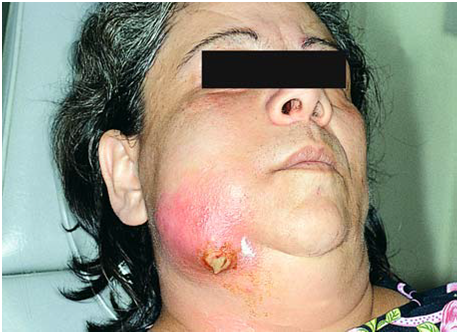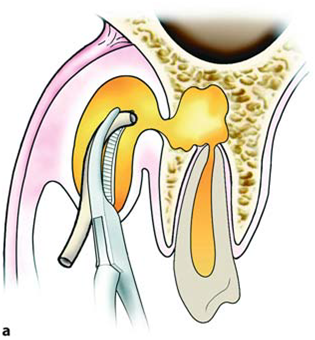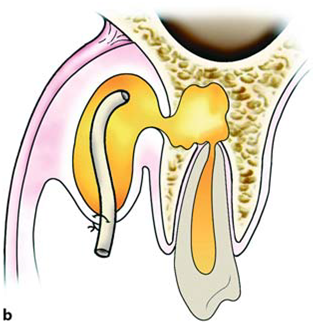In order to treat an acute dent alveolar infection as well as a fascial space abscess correctly, the following are considered absolutely necessary:
· Take a detailed medical history from the patient.
· Drainage of pus, when its presence in tissues is established.
This is achieved (1) by way of the root canal, (2) with an intraoral incision, (3) with an extraoral incision, and (4) through the alveolus of the extraction. Without evacuation of pus, that is with administration of antibiotics alone, the infection will not resolve.
· Drilling of the responsible tooth during the initial phase of inflammation, to drain exudate through the root canal, together with heat therapy. In this way, spread of inflammation is avoided and the patient is relieved of the pain. Drainage may also be performed with trephination of the buccal bone, when the root canal is inaccessible.
· Antisepsis of the area with an antiseptic solution before the incision.
· Anesthesia of the area where incision and drainage of the abscess are to be performed, with the block technique together with peripheral infiltration anesthesia at some distance from the inflamed area, in order to avoid the risk of existing microbes spreading into deep tissues.
· Planning of the incision so that:
– Injury of ducts (Wharton, Stensen) and large vessels and nerves is avoided.
– Sufficient drainage is allowed. The incision is performed superficially, at the lowest point of the accumulation, to avoid pain and facilitate evacuation of pus under gravity.
– The incision is not performed in areas that are noticeable, for esthetic reasons; if possible, it is performed intraorally.
· Incision and drainage of the abscess should be performed at the appropriate time. This is when the pus has accumulated in the soft tissues and fluctuates during palpation, that is when pressed between the thumb and middle finger, there is a wave-like
Incision for drainage of a sublingual abscess. The incision is performed parallel to the submandibular duct and the lingual nerve
Incision for drainage of a palatal abscess, parallel to the greater palatine vessels
Incisions for drainage of a submandibular or parotid (a), and a submasseteric (b) abscess. During cutaneous incisions, the course of the facial artery and vein must be taken into consideration (a), as well as that of the facial nerve (b)
movement of the fluid inside the abscess. If the incision is premature, there is usually a small amountof bleeding, no pain relief for the patient and the edema does not subside.
· The exact localization of pus in the soft tissues (if there is no fluctuation present) and the incision for drainage must be performed after interpretation of certain data; for example, ascertaining the softest point of swelling during palpation, redness of the skin or mucosa, and the most painful point to pressure. This area indicates where the superficial incision with a scalpel is to be made. If there is no indication of accumulation of pus to begin with, hot intraoral rinses with chamomile are recommended to speed up development of the abscess and toensure that the abscess is mature.
· Avoid the application of hot compresses extraorally, because this entails an increased risk of evacuation of pus towards the skin (spontaneous drainage)
Superficial incisions on the skin (a) and on the mucosa of the oral cavity (b)
Spontaneous extraoral (undesirable) drainage of an abscess, after the erroneous placement of hot compresses on the skin
· Drainage of the abscess is initially performed with a hemostat, which, inserted into the cavity of the abscess with closed beaks, is used to gently explore the cavity with open beaks and is withdrawn again with open beaks. At the same time as the blunt dissection is being performed, the soft tissues of the region are gentlymassaged, to facilitate evacuation of pus.
· Placement of a rubber drain inside the cavity and stabilization with a suture on one lip of the incision, aiming to keep the incision open for continuous drainage of newly accumulated pus.
· Removal of the responsible tooth as soon as possible, to ensure immediate drainage of the inflammatory material, and elimination of the site of infection. Extraction is avoided if the tooth can be preserved, or if there is an increased risk of serious complications in cases where removal of the tooth is extremely difficult.
· Administration of antibiotics, when swelling is generally diffuse and spreading, and especially if there is fever present, and infection spreads to the fascial spaces, regardless of whether there is an indication of the presence of pus. Antibiotic therapy is usually empiric, given the fact that it takes time to obtain the results from a culture sample. Because the microorganisms isolatedmost often in odontogenic infections are streptococci (aerobic and anaerobic), penicillin remains the antibiotic of choice for treatment.
Diagrammatic illustrations showing the incision of an intraoral abscess and the placement of a hemostat to facilitate the drainage of pus
Diagrammatic illustrations showing the placement of a rubber drain in the cavity and stabilization with a suture on one lip of the incision.
Treatment of Infection in Cellular Stage
In this stage, treatment of the infection depends on the location of existing pus. Localization, as already mentioned, may be intraalveolar, subperiosteal, submucosal or subcutaneous. Each of these cases is discussed in next posts.
Key Words : oral surgeons wisdom teeth extraction dental implant surgery doctor of dental surgery oral surgeon dental operation dental gum surgery wisdom tooth surgery dental surgery oral surgery doctor of dental surgery cosmetic dental surgery dental laser surgery cosmetic gum surgery laser gum surgery











Tidak ada komentar:
Posting Komentar